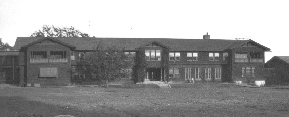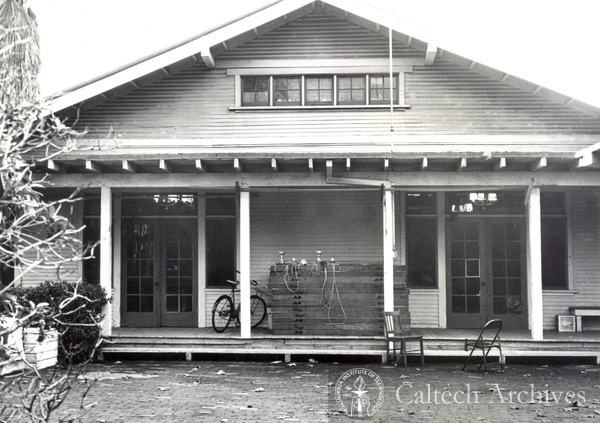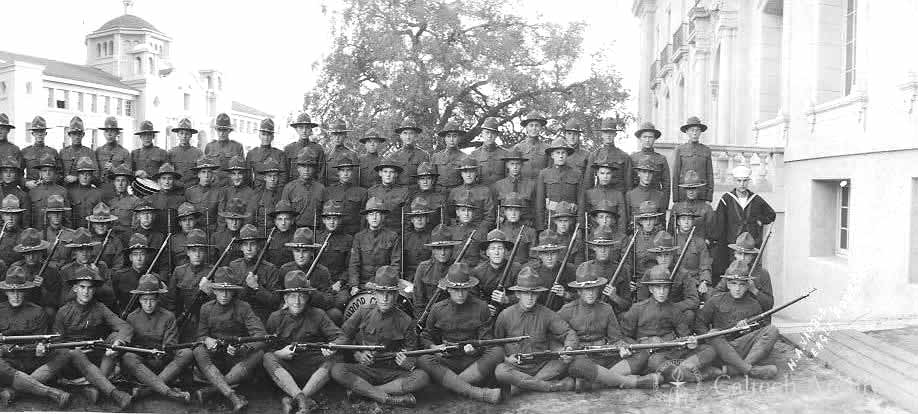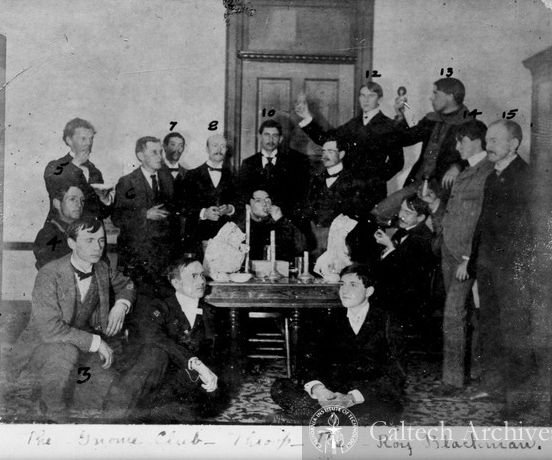UNDERGRADUATE STUDENT HOUSING: THE EARLY DAYS
Caltech began in 1891 when Amos G. Throop founded Throop University,
endowing it with his entire fortune of more than $100,000. In his diary
entry of September 1, 1891, Throop wrote:
``Planted potatoes, cleaned a water pipe, husked the corn ... In the
afternoon, saw Mr. Wooster and rented his block for five years... and
hope I have made no mistake.''
The articles of incorporation for Throop University were filed on
September 23, 1891. A Board of Trustees was organized and met for the
first time on October 2, 1891. Their first
business was to sign the five-year lease of the building known as the
Wooster Block at the corner of Fair Oaks Avenue and Kansas (Green) Street in
Pasadena.
Throop University, housed in the Wooster Block, first opened its doors on
November 2, 1891. There were 31 students and 6 faculty.
The school was co-educational and advertised itself
``..as an institution of learning embracing the different departments
and colleges of higher education, to furnish to students of both sexes
and all religious opinions a liberal and practical education which,
while thoroughly Christian, is to be absolutely non-sectarian in its
character''.
The brief circular which announced the event
mentions that the Wooster block contains
sufficient space for both instructional rooms and dormitories. The catalog for
the next year, 1892-93, provides more detail and states that two floors of the
Wooster building are being handsomely fitted up as living rooms for students
and that it
will be under the charge of the matron, Mrs. J.B. Sunderlin. The room
rate is less than one dollar per week. The catalog also states that arrangements are
being made for the opening of a Students Home Dining Hall in the immediate
vicinity of the Wooster Building.
In September, 1892, a new building known as
Polytechnic Hall was built a short distance away
at Fair Oaks and Chestnut Street. A two-storey brick structure, it
was intended
for the Manual Training Department. Partly because of this shift in
the instructional emphasis, the institution was renamed the Throop Polytechnic
Institute for the 1893-94 year. All class work was transferred to Polytechnic
Hall and Wooster Hall was then fitted out as the students home. The 1893-94
catalog says that 40 young men and thirty young ladies are to be housed, with
Mrs. J.B. Sunderlin and three members of the faculty in charge. The dining
hall is to be operated by students and faculty on ``the cooperative plan''. A
similar arrangement must have been in place for the previous year for the
1893-94 catalog states that the cost of room and board was less than $4.75
(per week ?). The catalog for 1893-94 also offers to find lodging
within the community for other students.
Either it was decided that the Wooster Hall arrangements were
unsatisfactory or, perhaps, there was some unfortunate incident in the
student accomodations but student housing was terminated after the 1893-94
year. The catalog for 1894-95 states that the decision was based on the fact
that there were quite sufficient and, indeed, superior accomodations within
the Pasadena community. Despite the abolition of the dormitory the number
of non-resident (i.e. non-local) students rose from 102 in 1893-94 to 144 in
1894-95.
From this point until the year 1903-04, no official accomodations were
provided by the Institute. Rather, beginning in 1897-98, the catalog
states that, if asked by the parents, the Institute will assume
responsibility for the care and oversight of students who board in homes
approved by the Institute. The situation changed again in 1904 when the
Board of Trustees voted to open a
boarding hall for boys and embarked on this experiment by leasing Mariposa
Hall for the 1904-05 year. A Miss Pease was in charge of this experiment
which, despite the lack of any prior publicity, was able to attract a
sufficient number of boys to almost break even. As a result the Board decided
to buy a larger property to serve as the dormitory for the following year,
1905-06. Thus they purchased the Franklin property at 289 North Los Robles
which, after enlargements and improvements, was deemed large enough to
accomodate at least 25 boys. However the number of applications for these
accomodations substantially exceeded the available space thus initiating
the first of many
housing crises in the history of the Institute. The result in 1905 was that
the Board leased a neighbouring property in order to house an additional seven
or eight boys. Apparently the dining room in the main building was large
enough to seat 40 boys. With these adjustments, 39 boys were
accommodated in the dormitories for the 1905-06 year; the residence was
called ``The Hall''. The catalog for
the following year, 1906-07, refers to this dormitory at 289 North Los
Robles as ``Throop Hall''. It includes a picture of the facility and
describes it as
consisting of a main building with 35 rooms plus two adjoining cottages in
grounds that include a tennis court and a playground. The main building has a
billiard room, a grand piano and ``plenty of books''. The facility is said to
house 40 to 50 boys supervised by the matron, Virginia Pease, who was in
residence. She was still matron in December, 1908. Room charges for 1906-07 were $375 to $425 per
year (tuition and fees included); in 1907-08 they rose to $390 to $440 and an
extra $8 was charged to those boys staying over the Christmas recess. By June
1907, Paul Boehncke, Associate Professor of German and Latin was also
living at Throop Boarding Hall and might therefore be considered the first
Master.
The matron, Viginia Pease, resigned during the summer of
1909 and was replaced by Mrs. A.H. Porter. Moreover Clinton K. Judy, Professor
of the English Language and Literature, also moved into the dormitory as a
representative of the Faculty and remained there until the year 1911-12.
It is interesting to note that the catalog of April 1909 mentions
that applicants for admission to the Hall must furnish satisfactory references
as to character and one of these reference forms is included as figure X.
The
Throop Dormitory continued in operation until the reorganization at the
beginning of the 1909-10 year. In that year Throop Polytechnic Institute
moved to its new site (where Caltech now stands) and the lower school,
which was called the Throop Academy,
occupied the old buildings. The Throop Dormitory seems to have remained a
joint facility of both schools for a brief time. Throop Academy, in its desire
to become a boarding school, also built a new bungalow dormitory which was
especially designed for that purpose. The 1909-10 Throop Academy Catalog
boasts ``that the
building will be the most modern school dormitory in the United States''.
We note that, in 1906, the trustees obtained the Fordyce home on
North Euclid as an annex to Throop Hall. It is not clear whether this
was used as an additional dormitory or whether it was used
for some other purpose.
In 1909-10, the first catalog published for Throop Polytechnic
Institute at its new site makes mention of ``the boarding Hall''.
However no such
mention is made in the catalog of the following year and none of the students
seem to have resided in any Institute-owned housing. The catalogs for the
years 1912-13, 1913-14 and 1914-15 clearly state that no dormitories are
maintained by the Institute. However, a book of illustrations dated
October 1914
includes a picture of the Bungalow Dormitory and the catalog dated
April 1915 states that this will be ready for use during the 1915-16 year.
The student annual tells
us that prior to 1915 this dormitory stood elsewhere and, in 1915, was
dismantled into several sections and reconstructed at the new site of the
Throop College of Technology. The student annual also
states that it was constructed at its original site in 1908 but this is
probably in error. There is little doubt that this is the Bungalow Dormitory
which the Throop Academy boasted of in its 1909-10 catalog.
The Dormitory served the students for many years and became known as
the ``Old Dorm''.
THE OLD DORM
In 1915 the College dismantled the wooden dormitory originally
built near the old site of the college and reconstructed it at the new
site of the Throop College of Technology. It was situated near the
present Winnett Center and separated from the Throop Building by a grove of
orange trees. The only other buildings on campus at this time were the Gates
Building and the Steam Laboratory.
The Dormitory was opened in the autumn of 1915 and housed approximately
60 students according to the 1917-18 catalog. The room rate for that year
was $ 60 per annum and an additional $ 5.75 per week for meals. Moreover,
the Trustees agreed on a governing structure for student housing
which, in modified form,
continues to this day. Specifically, the Trustees decided on a cooperative
management structure in which the school rented rooms to the students and
was responsible for the maintenance of the structure while the meals were
under the control of the students.
The Bulletin of the Throop College of
Technology in January 1916 states that
``The College has provided on the campus a
modern dormitory, of California bungalow type, two stories in height, with
large, airy, and well-lighted rooms for about sixty students - several of the
rooms having sleeping porches - and with attractive dining-room, living-room,
and recreation rooms.'' Frank Capra, who first registered as a student in
February 1915, remembers serving as one of five student waiters in the
Dormitory during his freshman year. He recalls that it housed 65 students
and that four of the five waiters received compensation in the form of room
and board. At the beginning, Capra was the fifth waiter and had to find
accommodation elsewhere.

|
|---|
| Throop House
|

|
|---|
| Throop House
|
Photographs including the Old Dorm can be found in both
the 1919-20 ``Orange and White'' and the 1921 Big ``T''.
The records show that student government within the houses began fairly
early for Charles F. Quirmbach was elected the President of the Dorm Club
in 1919-20. There may have been Presidents prior to that year but Charles
is the first of whom we have been able to find record.
The first record of Resident Associates occurs in the year 1929-30. The
1930 Big-T states that in that year ``Two graduate physicists, Carlyle
Mouzon and Lynn Rumbaugh have been
installed in the house in case any disorder should arise''.
In that year of 1929-30, the President was Jerome Muller and the dormitory
housed 52 freshmen supervised by the matron, Miss McFarlin.
We note that the Dorm had a
faculty member to dinner each Thursday.
After the four student houses were
completed in 1930-31, the Old Dorm was renovated in 1931-32 and
converted to a club for the
non-resident students. This was known as the Non-Resident Club and later
as Throop Club though it was often referred to simply as ``The Club''.
The Old Dorm was
finally demolished about 1960 during the construction of the North Houses,
Page, Lloyd and Ruddock. During its fifty year life it had served as a
dormitory, coffee shop, barber shop and home of Throop Club. Though remembered
fondly, Lance Taylor ('62)
(see Calif. Inst. of Tech. Quarterly, Vol.2, No.1, 1960) notes that ``the Old
Dorm looked, creaked and smelled like a fire trap''.
The following are the student Presidents and resident associates who were
connected to the Dorm Club and the Throop Club:
| | President | Resident Associates
|
|---|
| | |
|
| Dorm Club: | | |
| 1919-20 | Charles F. Quirmbach | |
| 1920-21 | Paul R. Ames | |
| | Edward L. Champion | |
| 1921-22 | Dewey C. Rohloff | |
| | | |
| 1929-30 | Jerome Muller | Carlyle Mouzon & Lynn Rumbaugh |
| 1930-31 | George S. Smith | |
| | | |
| | | |
| Non-resident club: | | |
| 1931-32 | Madison T.Davis | |
| 1932-33 | Samuel Johnson | |
| 1933-34 | | |
| | | |
| Throop Club: | | |
| 1934-35 | Richard Jahns | |
| 1935-36 | Wally Swanson | |
| 1936-37 | Alton Pabst | |
| 1937-38 | | |
| | | Faculty Associates: |
| 1938-39 | | L. Winchester Jones |
| 1939-40 | Charles Palmer | L. Winchester Jones |
| 1940-41 | Frank Casserly | L. Winchester Jones |
| 1941-42 | Robert Wilmoth | L. Winchester Jones |
| | Robert Nahas | |
| | David Elmer | |
| 1942-43 | | |
| 1943-44 | Robert C. Poolman | Hardin Craig, Edward Guerrant |
| 1944-45 | Ken Anspach | Hardin Craig |
| 1945-46 | Herbert W. Strong | |
| | Larry Haupt | |
| 1946-47 | Jack Froelich | |
| 1947-48 | Robert Benton | |
| 1948-49 | Gene Mooring | |
| 1949-50 | Ralf Erickson | |
| 1950-51 | Duane Neverman | |
| 1951-52 | Gil Kitching | |
| 1952-53 | Gene Muehlberger | |
| 1953-54 | John Lloyd | |
| 1954-55 | John Andelin | |
| 1955-56 | John Moser | |
| | | Resident Associates: |
| 1956-57 | Mike Duke | |
| 1957-58 | Dick Cooper | John Andelin |
| 1958-59 | John Everitt | Dick & Lorna Cooper |
| 1959-60 | Fletcher Gross | Michael Duke |
Caltech faculty who were members of Throop:
| Name | Degrees | Faculty Affiliation
|
|---|
| John R. Pierce | BS '33, MS '34, PhD '36 | Electrical Engineering |
| Charles H. Wilts | BS '40, MS '41, PhD '48 | Electrical Engineering |
| David S. Wood | BS '41, MS '46, PhD '49 | Material Science |
| Robert B. Leighton | BS '41, MS '44, PhD '47 | Physics |
| Hardy C. Martel | BS '49, PhD '56 | Electrical Engineering |
| W. Barclay Kamb | BS '52, PhD '56 | Geology and Geophysics |
| Fred C. Anson | BS '54 | Chemistry |
| Wilfred D. Iwan | BS '57, MS '58, PhD '61 | Applied Mechanics
|
WORLD WAR ONE

|
|---|
| Reserve Officer's Training Corps, Engineer Unit, at Caltech during World War I. In the left background is Throop Hall, on the right
is Parsons-Gates.
|
World War One Calender:
- Sep., 1916. Establishment of Reserve Officer's Training Corps, Engineer Unit.
- March 22, 1917. First Throop volunteers leave for War.
- Jan., 1918. A speeded-up schedule for the War is adopted at Throop.
- Feb., 1918. First mid-year Frosh class admitted.
- Apr.7, 1918. First ``War Commencement''.
- Aug., 1918. War Laboratory erected and occupied.
- Sep.15, 1918. Second ``War Commencement''.
- Oct.1, 1918. Students Army Training Corps established.
- Dec.12, 1918. Re-establishment of Reserve Officer's Training Corps, Engineer Unit.
- June 18, 1919. Third ``War Commencement''.
FRATERNITIES
The history of fraternities at the Institute is interesting because of a
special agreement between then President Robert Millikan and the
undergraduate students, an agreement which is still intact today, more
than sixty years later.
There are some indications that, from the earliest days of the Institute,
the Trustees were wary of
fraternities and wished to prevent their establishment. For example,
they passed the following rule which is stated in the 1917-18 catalog:
``In no case shall more than 10 students be domiciled together in any
quarters other than the College Dormitory.''
Fraternities, as such, did not develop at the Institute until about
1920 when the Sigma
Alpha Pi fraternity acquired its house on South Mentor.
Of course, the Gnome Club was much older but was more akin to a club
than a fraternity in its early days.
In the 1920s, the fraternities multiplied rapidly, because of the obvious
housing needs of the students. This development alarmed
Millikan and the Trustees who disliked these institutions and
wanted to suppress their development at the Institute.
They seized their chance during the negotiations over the building of the
first Student Houses, those we now call the south houses. Millikan
forged a deal with the students in which he pledged his support for the
construction of the four Houses if the students would pledge an end to
the fraternities. The Gnomes, as the oldest group directly affected,
raised the most objections and Gnome alumni continued to protest this
arrangement which would mean the inevitable demise of what had become
an alumni institution. Some years later the Gnomes reached an agreement
with President Lee du Bridge in which the Gnomes would be allowed to
solicit members
from new alumni but not from registered students. These arrangements have
continued to this day, effectively eliminating fraternities from operating
on campus. However it is also true that many of the symbols
and customs associated with the fraternities moved into the Student
Houses with the students in 1931. For example, the coats of arms used
by the south houses originate with the fraternities whose membership
made up a significant fraction of the house membership in 1931.
GNOME CLUB
The Gnome Club was founded on March 9, 1897. The Throop Polytechnic
Institute catalog for 1897-98, page 39, states that a literary society, the
Gnome Club, open only to young men, is maintained by the students to afford
an opportunity for training in debating and other skills. While other
such clubs were begun in the early days none but the Gnome Club survived
for any length of time. The Gnomes prospered and during the period
1897-1920 evolved into a fraternity, even to the extent of assuming the
Greek letters Kappa Gamma. Pre-1931 faculty members associated with the Gnomes
included Royal Sorenson, Clinton Judy, Horace Gilbert, Romeo Martel and Harry
van Buskirk. Prior to 1921 the Gnomes occupied a small fraternity house at 351
South Euclid. Next door lived Professor Daugherty and his wife who thus began
a long association with the Gnomes. In 1921 the Gnomes moved to a larger
house, 289 South Madison at the northwest corner of Madison and Del Mar.

|
|---|
| First photo of Gnome Club in 1897.
|
For many years in the 1920s, Gnome initiates were required to crawl on hands and
knees through the storm drain which ran underneath the campus, starting at San
Pasqual and ending on the south side of California. Apparently there was a
particularly narrow section under California. Another hassle
involved the initiate sitting with bare buttocks on a block of ice until
he could make the fraternity members laugh.
When the fraternities were dissolved in 1930-31 the Gnomes almost all moved
into the new Ricketts House. The student Presidents of the Gnomes were:
| Year | President | Year | President
|
| 1897-98 | James C. Creamer | 1898-99 | |
| 1899-00 | | 1900-01 | |
| 1901-02 | | 1902-03 | |
| 1903-04 | | 1904-05 | |
| 1905-06 | | 1906-07 | |
| 1907-08 | | 1908-09 | |
| 1909-10 | | 1910-11 | |
| 1911-12 | | 1912-13 | |
| 1913-14 | | 1914-15 | |
| 1915-16 | | 1916-17 | |
| 1917-18 | | 1918-19 | |
| 1919-20 | | 1920-21 | Ed Forgy |
| 1921-22 | Louis Erb | 1922-23 | |
| 1923-24 | Fred Groat | 1924-25 | |
| 1925-26 | | 1926-27 | |
| 1927-28 | | 1928-29 | |
| 1929-30 | Roscoe P. Downs | 1930-31 | Robert Oaks
|
SIGMA ALPHA PI
The Sigma Alpha Pi fraternity was established at the Institute in 1914. By
1921 they had acquired a house at 399 South Mentor and retained it until
they were disbanded in 1931.
Pre-1931 faculty members associated with Sigma Alpha Pi included Arnold
Beckman, William Lacey and Franklin Thomas.
When the fraternities were dissolved in 1930-31 the members of Sigma Alpha Pi
almost all moved into the new Fleming House. The student Presidents of
Sigma Alpha Pi were:
| Year | President | Year | President
|
| 1914-15 | | | |
| 1915-16 | | 1916-17 | |
| 1917-18 | | 1918-19 | |
| 1919-20 | | 1920-21 | |
| 1921-22 | | 1922-23 | |
| 1923-24 | | 1924-25 | |
| 1925-26 | | 1926-27 | |
| 1927-28 | | 1928-29 | |
| 1929-30 | Jack B. Sturgess | 1930-31 | Sam C. Eastman
|
PI ALPHA RHO (PHAROS)
Founded at the Institute in 1921, the Pharos fraternity in 1930
had a house at 593 East California.
Pre-1931 faculty members associated with Pi Alpha Rho included
A.A. Noyes, E.H.Swift, Robert Knapp and Ernest Sechler.
When the fraternities were dissolved in 1930-31 the Pharos almost all moved
into the new Blacker House. The student Presidents of Pi Alpha Rho were:

|
|---|
| Study at the Pharos House.
|
| Year | President | Year | President
|
| 1921-22 | | 1922-23 | |
| 1923-24 | | 1924-25 | |
| 1925-26 | | 1926-27 | |
| 1927-28 | | 1928-29 | |
| 1929-30 | Emory L. Ellis | 1930-31 | John Mehl
|
GAMMA SIGMA
Founded at the Institute in 1925, the Gamma Sigma fraternity in 1930
had a house at 415 South El Molino.
Pre-1931 faculty members associated with Gamma Sigma included Arthur Fleming
and L. Winchester Jones.
When the fraternities were dissolved in 1930-31 the members of Gamma Sigma
almost all moved into the new Dabney House. The student Presidents of
Gamma Sigma were:
| Year | President | Year | President
|
| 1925-26 | | 1926-27 | |
| 1927-28 | | 1928-29 | |
| 1929-30 | John C. Shields | 1930-31 | C. Emery Buffum
|
PI ALPHA TAU
Founded at the Institute in 1921, the Pi Alpha Tau fraternity in 1930
had a house at 330 South Lake.
Pre-1931 faculty members associated with Pi Alpha Tau included Harvey
Eagleson and Fred Converse.
When the fraternities were dissolved in 1930-31 the small number of
members of Pi Alpha Tau almost all moved into the new Fleming House.
The student Presidents of Pi Alpha Tau were:
| Year | President | Year | President
|
| 1921-22 | | 1922-23 | |
| 1923-24 | | 1924-25 | |
| 1925-26 | | 1926-27 | |
| 1927-28 | | 1928-29 | |
| 1929-30 | William F. Kelley | 1930-31 | Thomas Bell
|
Last updated 4/10/04.
Christopher E. Brennen